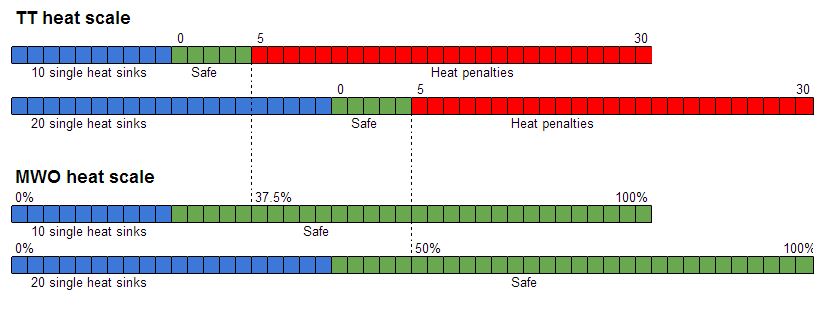 Training Instructor, on 07 November 2013 - 06:24 AM, said:
Training Instructor, on 07 November 2013 - 06:24 AM, said:
I've always found this strange, but what's the logic in increasing a mech's heat capacity? Heat capacity is determined by the people who designed and engineered the components of the mech, cooling has no effect on the failure point of components. All heat dissipating devices, such as heat sinks, can do, is work hard to cool components fast enough to prevent them from reaching that failure point in the first place.
Example: The video cards in the computers of most gamers are fairly high end, heat generating monsters. You'll notice that on most of these cards there's a fan and metal fins attached, the metal fins of course are called heat sinks, indicating their prime purpose in the design. The harder load you put on your video card, the more heat it generates, and the more you hear the fan whirring. If the fan fails, or if the ambient operating temperature inside the computer case is too hot, because you're playing in Phoenix in July with no air-conditioning, your GPU will shut itself down once it reaches a heat threshold, at which point the failsafe kicks in and shuts down the card to prevent permanent damage.
If your GPU has a heat tolerance of say, 200 degrees Celsius before the failsafe kicks in to shut it down, adding four more fans and a liquid nitrogen cooling system is not going to do anything to prevent that shutdown if you take some action to send a heat spike to your card. Now, what all those extra fans and heatsinks will do is allow your GPU to cope with high heat over time by preventing it from ever getting near 200 degrees Celsius in the first place. This is dissipation rate, not heat capacity. These devices do not allow the card to operate at 201 degrees Celsius, they only help prevent it from ever reaching the temperature.
And that, ladies and gentlemen, is why I think heat sinks increasing the heat cap is a ridiculous idea.
p.s. Yes, I know giant stompy robots is also a ridiculous idea.
As your last sentence acknowledges, trying to explain any sort of BT/MW mechanic with real world physics is bonkers, so I'll spare you the lecture I would give to most people about why that's bad, and how we should only be balancing around what makes the game to play.
With that in mind, I'll answer the question in your thread title that you don't really elaborate on in the post beyond saying it makes no real world sense: why do heatsinks increase capacity? The answer is because of how heat works differently between MWO and BT. In the TT game, your heat dissipates in the same turn that you generate it; in an attempt to simulate heat working the same way, MWO gives additional capacity so that after one Battletech-turn of heat sinking is over, a mech will be at the same place, but during that 10-second window it suffers no deleterious effects for what should be a reasonable amount of heat generation.
Let's take the AWS-8Q as a case study. It mounts 3 PPCs and 28 single heatsinks (we'll ignore the small laser. I always do in mine, anyway). In Battletech, if a pilot were to fire all three PPCs, he would generate 3x10 = 30 heat, which puts him exactly at the top of the heat threshold. According to the game rules, he should immediately be shutting down and his mech should be exploding all over the place. But wait! Because of how the TT game works, the 28 sinks immediately remove 28 of the 30 heat, which bring the mech down to just 2 heat. Since TT is a turn-based game that doesn't have to make sense in the real world, the Awesome never reaches the max heat capacity, even though firing three PPCs seems to imply that it should do so immediately. As a result, the AWS-8Q is an excellent direct-fire support mech, and is able to alpha strike almost every turn with very few ill effects.
In contrast, an AWS-8Q in an exact copy of MWO but without heatsinks capacity increases fires three PPCs at once, exactly like in the tabletop game. In this MWO, the Awesome immediately shuts down and takes internal damage, because unlike in BT, heat is applied instantly. After ten seconds, the nominal cooling period in TT, the AWS would be booted up and back down to 2 heat just like in the tabletop game. As the volleys continue to fire, the TT AWS-8Q builds up 2-4-6-8 heat, then switches to firing just 2 for a round, goes back to 0 heat, and starts to hammer away with all three guns every round again. In contrast, the MWO AWS-8Q goes further and further into overheating and shutdown if it follows the same pattern, building up 32-34-36-38 heat for periods of time. After that point, the issue is moot because the MWO Awesome has died from internal damage.
In short: the reason MWO heatsinks increase capacity is so that mechs which rely heavily on energy weapons are not penalized for having their heatsinks work over time instead of instantly like in the tabletop game.
 Training Instructor, on 07 November 2013 - 06:24 AM, said:
Training Instructor, on 07 November 2013 - 06:24 AM, said:





























